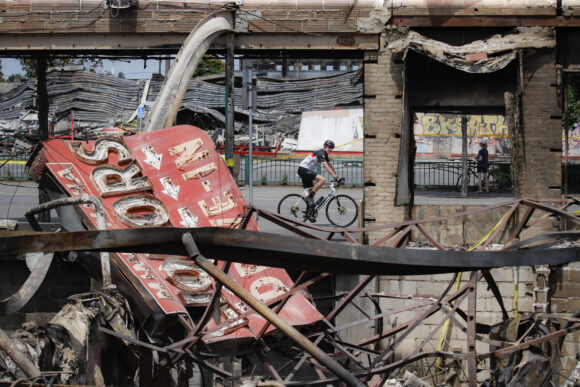Insurers traditionally have offered protection against strikes, riots and civil commotion (SRCC) at no extra cost, but the increased frequency and severity of these risks means property insurers have begun excluding events of social unrest from policies, according to a report published by Chubb.
“Driven by increased frequency and losses, property insurers are increasingly looking to limit SRCC cover particularly for those assets more prone to damage or located in central business or major metropolitan areas where large scale damage can occur,” said the report titled Confidence in Conflict: Insuring Your Business Against Civil Unrest.
The report aims to help reduce the risk of contested claims and to ensure that risk managers, their businesses and assets are protected adequately through clear and understandable SRCC insurance covers.
The first step in planning for SRCC risks is to identify which insurance programs provide the appropriate coverage, the report recommended. “To prepare for the potential damage and disruption caused by civil unrest, risk managers need to ensure bespoke insurance programmes are in place to protect their balance sheets and international assets,” it affirmed.
“It is critical for risk managers and business leaders to be aware of how the risk spectrum is evolving and the consequential effects this will have on their insurance programs,” the report said. “Now more than ever, insurance policies covering losses caused by civil protests and political uprisings need greater clarity and transparency in order to provide the coverage and certainty that clients demand.”
It is also critical for companies to understand the limitations and exclusions which can affect the coverage of SRCC losses, as well as the specific risk exposures during events of civil unrest that will have an impact on their business.
Black Lives Matter Protests
The report looked at some recent examples of civil unrest around the globe, including last year’s Black Lives Matter (BLM) protests after the murder of George Floyd, and their effect on insurance policies. More than 26 million people took to U.S. to protest police brutality and racial discrimination. “Protests often degenerated into violence and looting and, according to the U.S. Property Claims Service, damage to property totalled more than $2 billion,” recalled the report.
“Traditional property insurance policies were tested [as a result of the BLM protests] as questions arose about proximate causes and the underlying motives of the individuals involved in the protests,” said the report.
“As the disturbances happened over many months and across 20 states, they stretched the boundaries of property insurance and brought into focus the need for precise language that defines which risks are covered by a policy and which are excluded.”
The BLM protests also showed that a company that saw losses could have benefited from standard SRCC cover within their property policy, and a political violence extension would have been more likely to capture all damage arising from the protests, the report said.
Report Highlights
Key takeaways from the report include:
- Property damage insurance previously covered losses linked to civil unrest, with no questions asked, but this is no longer the case.
- SRCC standalone policies and extensions in political violence policies are more likely to provide comprehensive protection.
- Standard terrorism insurance typically covers isolated, covert terrorist attacks, but not street level civil unrest.
- Standard all-risks property policies usually exclude terrorism or war related events. This typically includes insurrection, rebellion, revolution, war and civil commotion amounting to or assuming the proportions of an uprising.
- Different policies may define perils in different ways, so a successful property and terrorism insurance program is underpinned by consistency of language.
- SRCC cover is increasingly offered by specialty insurers, which employ stricter definitions and aggregate losses.
- It is important to pay attention to the language of the policy and work closely with brokers and insurers, in order to avoid headaches when there is a claim.
- Distinctions between diferent terms and defnitions can become blurred as civil unrest episodes develop in complexity and scope. For example, in the Arab Spring, several countries went through regime change preceded by violent unrest and policyholders discovered they did not have cover that responded to the developing circumstances.
- Traditional definitions of political violence and civil unrest again have been challenged by recent events in Chile and Hong Kong and the BLM movement in America.
- Working with their insurers, businesses need to monitor key risks closely and protect themselves by securing their premises, people and supply chains, and having an effective business continuity plan.
- It is critical for both risk managers and business leaders to be aware of how events and circumstances may evolve over time, potentially triggering different insurance policies.
“[R]isk managers need to ensure bespoke insurance programs are in place to protect their balance sheets and assets. Using case studies, the report aims to open a much-needed dialogue with risk managers about the evolving risks, their SRCC protection needs and how to meet them within this complex environment,” said Piers Gregory, head of Terrorism & Political Violence, Chubb Overseas General and co-author of the report, in a statement accompanying the report’s publication.
“Now, more than ever, insurance policies covering losses caused by civil protests and political uprisings need greater clarity and transparency to provide the coverage and certainty that clients demand,” Gregory added.
“It is critical for companies to understand the limitations and exclusions which can affect the coverage of SRCC losses, as well as the specific risk exposures during events of civil unrest that will have an impact on their contracts,” he emphasized.
“Recent civil unrest events have brought into sharp focus the interpretation and application of traditional civil unrest perils typically seen in insurance policies,” said Patrick Foss, a partner at global law firm Kennedys, which provided legal input for the report.
“As always, clear policy drafting is of utmost importance, and both insurers and policyholders alike must carefully consider the terms of their policies and how they are likely to respond to various scenarios,” he said.
The report also was developed with data from information, analytics and solutions specialists IHS Markit.
Source: Chubb
Photograph: Pedestrians pass the burnt ruins of the Minnehaha Liquor store near the Minneapolis 3rd Police Precinct, Tuesday, on June 2, 2020, in Minneapolis. Protests followed the death of George Floyd, who died after being restrained by Minneapolis police officers on May 25. Photo credit: AP Photo/John Minchillo.
Was this article valuable?
Here are more articles you may enjoy.



 White House Seeks to Bring Financial Regulators Under Its Sway
White House Seeks to Bring Financial Regulators Under Its Sway  Class Action Accuses Toyota of Illegally Sharing Drivers’ Data With Progressive
Class Action Accuses Toyota of Illegally Sharing Drivers’ Data With Progressive  3 Emerging Risks to Watch: 6G Wireless Technology, Autonomous Trucks, Kratom
3 Emerging Risks to Watch: 6G Wireless Technology, Autonomous Trucks, Kratom  Don’t Forget Tariff Impacts on Workers’ Compensation: Berkley
Don’t Forget Tariff Impacts on Workers’ Compensation: Berkley 

